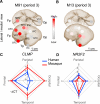Cortical evolution: judge the brain by its cover
- PMID: 24183016
- PMCID: PMC3922239
- DOI: 10.1016/j.neuron.2013.10.045
Cortical evolution: judge the brain by its cover
Abstract
To understand the emergence of human higher cognition, we must understand its biological substrate--the cerebral cortex, which considers itself the crowning achievement of evolution. Here, we describe how advances in developmental neurobiology, coupled with those in genetics, including adaptive protein evolution via gene duplications and the emergence of novel regulatory elements, can provide insights into the evolutionary mechanisms culminating in the human cerebrum. Given that the massive expansion of the cortical surface and elaboration of its connections in humans originates from developmental events, understanding the genetic regulation of cell number, neuronal migration to proper layers, columns, and regions, and ultimately their differentiation into specific phenotypes, is critical. The pre- and postnatal environment also interacts with the cellular substrate to yield a basic network that is refined via selection and elimination of synaptic connections, a process that is prolonged in humans. This knowledge provides essential insight into the pathogenesis of human-specific neuropsychiatric disorders.
Copyright © 2013 Elsevier Inc. All rights reserved.
Figures


References
-
- Anderson SA, Marín O, Horn C, Jennings K, Rubenstein JL. Distinct cortical migrations from the medial and lateral ganglionic eminences. Development. 2001;128:353–363. - PubMed
-
- Anton ES, Kreidberg J, Rakic P. Distinct functions of alpha3 and alpha(v) integrin receptors in neuronal migration and laminarorganization of the cerebral cortex. Neuron. 1999;22:227–289. - PubMed
Publication types
MeSH terms
Grants and funding
LinkOut - more resources
Full Text Sources
Other Literature Sources

